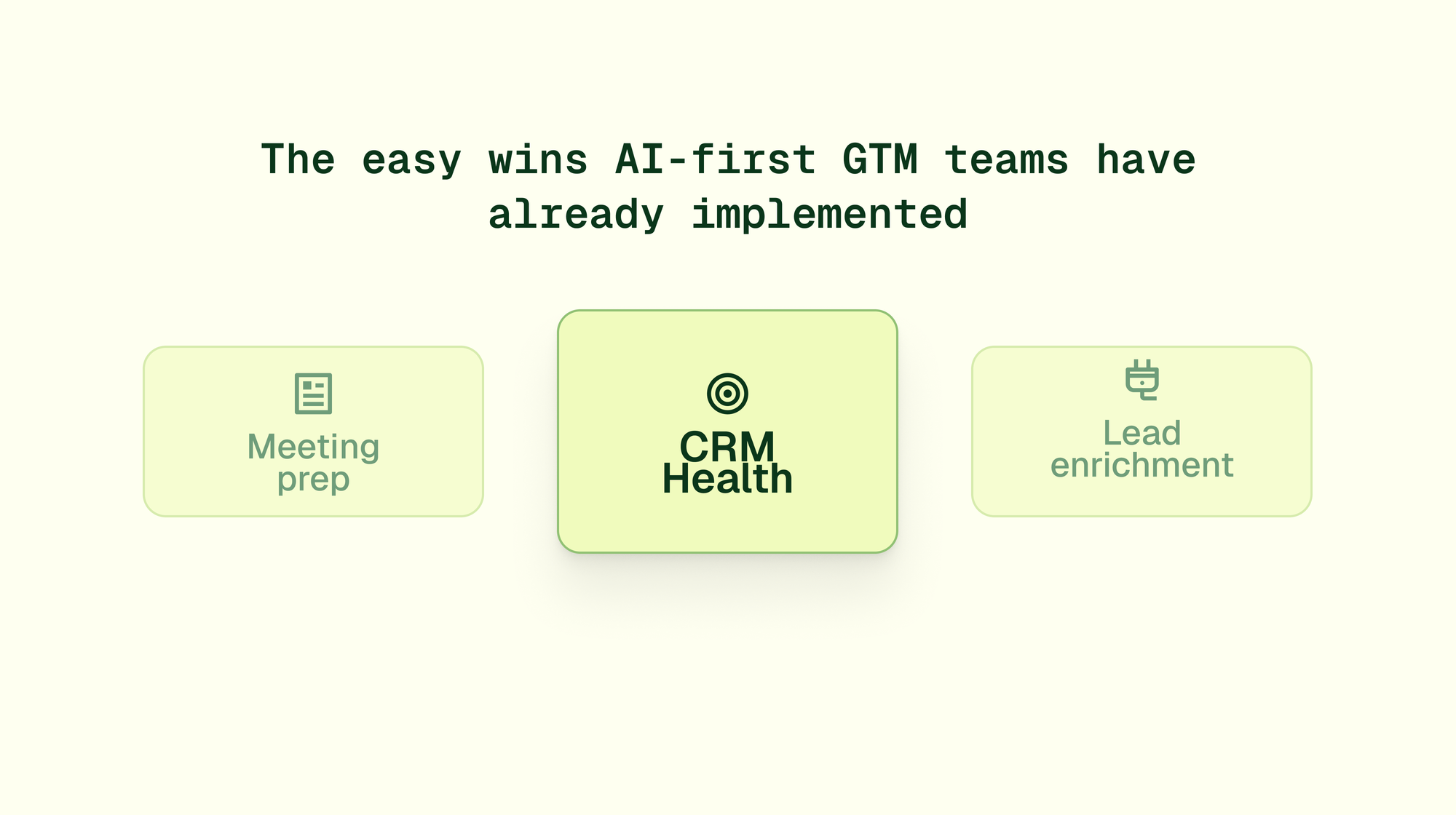The easy wins AI-first GTM teams have already implemented

I’ve never envied AI software buyers less. AI is amorphous, the landscape changes weekly, and there’s no established playbook for what an AI‑first organization should look like. Plus, there’s a pervasive feeling that if they aren’t adopting AI, they’re falling behind.
Many teams come to Dust asking us to solve a handful of specific GTM use cases. But the questions behind the question are bigger. How should we reshape the org now that AI is transforming how work gets done? How do we make sure we’re keeping up?
The short answer: automate the repetitive, low-leverage tasks that already exist. Shift your team's time from low-impact work to work that only humans can do. Teams that use Dust are already seeing roughly 20% efficiency gains, pacing toward 50% within 12 months.
As someone who has spent the last decade selling at early-stage companies in hypergrowth, I've observed something about implementing AI for GTM teams. It's very easy to see and quantify the friction points, but it's always a trade-off: if you fix one stage, you often create a new constraint elsewhere and the limiting factor is usually time — scale outreach or personalize, pristine CRM hygiene or relationship building, best practices or raw velocity.
That's why Dust enables you to solve not only the immediate problem in front of you, but also every problem that emerges subsequently. It removes those false choices.
In practice, AI actually does two things exceptionally well:
- accelerates your highest‑priority work
- quietly handles the cleanup or best practices you know matter but never had time to prioritize
Ready to implement AI in your GTM teams? Here are the easy wins that your team should already be leveraging to do more, move faster, and hit bigger numbers:
Research and context: ways to drive higher response rates and conversion
Lead enrichment: The moment someone raises a hand (signup, contact form, demo request), agents scan for past interactions, check mutual LinkedIn connections, qualify the company against our ICP (Ideal Customer Profile), start deep research, and enrich the record directly in HubSpot.
Personalized outreach: Using that research, a second agent drafts hyper‑personalized emails in my tone (without sounding like a robot), mapping likely pains to Dust’s capabilities. Or directly following calls, it crafts responses and proposals for me referencing exactly what was spoken about in the meeting and drops the draft directly in Gmail.
Meeting prep: Instead of juggling fifteen tabs - LinkedIn, website, news, call notes - I can skip the scavenger hunt and let an agent draft briefings in minutes with strategic talking points pulling from relevant case studies, use cases, and patterns from similar customers. Your choice whether you want to call the agent minutes before the meeting or receive a daily briefing for everything on your calendar that day.
Account snapshots & Handoffs: Everyone in GTM has gotten the ping "what's up with this deal?" Rather than scrambling to piece together information, agents can instantly pull a comprehensive view of all customer touchpoints, usage data, and relevant support tickets. Managers can self-serve, account handoffs are automated and everyone gets the full relationship history: themes, use cases, pain points, and strategic context, and everyone on the deal gets full context, including complete relationship history, conversation themes, use cases, pain points discussed, strategic context.
Eliminate administrative overhead: give reps time back to focus on higher-leverage work
CRM data hygiene: Good updates can often take 30 minutes after a call. With a full day of calls, that’s time you don’t have but when they slip, it leads to downstream problems. Now, insights, context, and next steps are extracted from transcripts and logged to custom fields automatically, so the data is both trustworthy and actionable.
Security questionnaire automation: Complex RFPs and security questionnaires can kill deal momentum - 3-4 hours of work coordinated across multiple teams just to respond to one questionnaire. We run a two‑agent pattern: one drafts using historical responses, current docs, and standard frameworks; the second acts as a judge for QA. Time drops to 15–20 minutes of review and tailoring—plus improved consistency and accuracy.
To do list tracking & prioritization: My past processes have been a combination of tracking customer commitments and internal action items manually or looking at a report filtered on last activity trying to remember who I haven’t talked to recently. Now, my task management agent monitors internal and external commits across channels then builds a prioritized task list with context and due dates. It weighs deal size, urgency signals, and relationship temperature, so I’m always working on what moves revenue or and making sure I’m not a bottleneck for other teams.
Enablement, onboarding, and real-time intelligence: leverage instant knowledge to drive better conversations
Onboarding and ongoing enablement: Rather than management or tenured employees consistently answering repetitive questions, Dust agents act as auto-responders directly in Slack to answer questions about product features, competitive positioning, deal status, and process by pulling from Salesforce, Gong, Slack, Notion, and Google Drive. When someone adds context that often exists only in people’s heads, the agent pulls those details back in as a data source meaning the next time someone asks the same question, it will be even smarter. The result: teams self‑serve answers instantly instead of waiting for a reply or a training session.
Voice‑of‑SE: With a horizontal product, I’m as likely to be working directly with a Head of Engineering or a CIO as I am a sales leader whose workflows I’m more familiar with. When I get a particularly technical question and my engineer Frank can’t hop on the call, instead of having to say “I’ll get back to you,” my agent (also named Frank) walks me through the concepts in layman’s term and the prospect in language that’s tailored to them. On the backend, it took me ~15 minutes to give the agent access to our existing documentation and pull calls our CTO has taken with customers. Bonus: new reps love getting to sound like senior solutions engineers from day one instead of waiting months to ramp up product knowledge.
Competitive intelligence: When a competitor launches a new feature or a customer brings up a new objection, agents update battlecards in Notion automatically. This means when I'm on a call and someone mentions a competitor, I'm looking at current intelligence, not a battlecard that's six months out of date.
Pattern recognition: scaling best practices and pipeline intelligence
Maximizing best practices: Successful pitches are captured across calls so if someone says, “This seems expensive compared to [competitor],” I can see how our best reps handled that exact concern instead of scrambling for talking points. Alternatively, if marketing wants to track what messaging resonates best with each audience, they don’t have to listen to dozens of calls to get a pulse and guess. It scales our collective knowledge across the entire team and turns every successful conversation into a learning opportunity for everyone else.
Voice of the customer: Feedback from calls, email, tickets, and product usage is synthesized into actionable insights and trends that can be tracked over time. Organizational visibility means Product gets a sharper roadmap, and customer-facing teams can advocate for features accurately sized with the revenue it would unlock, etc.
Pipeline Intelligence: Subtle conversation shifts -slower replies, sentiment trending negative, fewer stakeholders engaging- trigger alerts. This doesn’t make salespeople irrelevant; it helps us intervene earlier, focus our efforts where they're most impactful and catch issues before deals go sideways.
Quantitative results: measuring ROI from AI-first GTM implementation
GTM teams usually see minimum 20% efficiency gains and adoption spiking to 70% within 2 months:
- 20% efficiency gains across all sales activities
- Response times shortened from hours to minutes
- Meeting productivity increased through better preparation
- Administrative work reduced by 70%
But the real change is qualitative: better conversations and stronger relationships because reps are listening rather than note-taking. Adding more value and closing deals faster because they have the mental space for strategic thinking.
This isn't about replacing people or human versus AI. It's getting to the value tech was always supposed to add as a tool, handling busywork so people can focus on what they do best: understanding customer needs, building trust, and creating solutions that deliver real value.
AI transformed the operational burden, but it made the human elements more important, not less.
What AI can't replace: relationship building is still everything
AI gives me perfect context and talking points, but it can't build trust with a prospect. It can draft follow-up emails, but it can't read the room during a tense negotiation. It can analyze conversation patterns, but it can't provide the emotional intelligence needed for complex stakeholder dynamics. What AI did is remove barriers that prevented me from focusing my effort on where it was most needed.
The best parts of sales - understanding unique customer challenges, designing custom solutions, thinking creatively about implementation - remain human territory.
Upcoming: we’ll share how companies are driving adoption and shifting their teams to be AI-first. In the meantime, if you’re curious to implement any of these, feel free to reach out.
*This article was drafted with Dust's help, under Gina's supervision, all in under 10 minutes.

